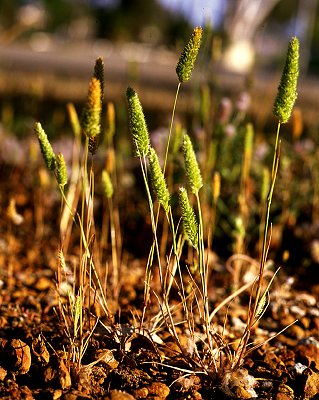 |
 |
|
 |
 |
|

Rostraria cristata (Vill.) Pers.
|
Common name
Annual Catstail
Derivation
Rostraria Trin., Fund. Agrost. 149 (1820); from Latin rostrum
(beak or rostellum), alluding to the shape of the lemma apex in the type specimen.
cristata- Latin for crested. Inflorescence forming a crest.
Published in
Syn. Pl. 1: 97 (1805).
Common synonyms
Koeleria phleoides (Vill.) Pers.
Lophochloa cristata (L.) Hylander
Lophochloa phleoides (Vill.) Reichenb.
Habit
Annual, culms solitary or tufted. Culms erect or decumbent, 5–45 cm tall.
Leaves mostly basal. Ligule an eciliate membrane, 1 mm long. Leaf-blades flat,
2.5–15 cm long, 1.5–8 mm wide, flaccid. Leaf-blade surface glabrous
or pubescent.
Inflorescence
Inflorescence solid, a panicle. Panicle spiciform, linear or lanceolate, continuous
or interrupted, 1.5–10 cm long, 0.6–1.6 cm wide. Panicle branches
smooth or scaberulous.
Spikelets
Spikelets solitary. Pedicels oblong. Fertile spikelets many flowered, comprising
3–8 fertile florets, with diminished florets at the apex, oblong, laterally
compressed, 3–7 mm long, breaking up at maturity. Spikelets disarticulating
below each fertile floret. Rhachilla internodes definite, pubescent.
Glumes
Glumes persistent, similar to each other and to fertile lemma in texture, shiny,
gaping. Lower glume lanceolate, 2–3 mm long, 70% length of upper glume,
membranous, 1-nerved. Lower glume lateral nerves absent. Lower glume surface
glabrous or puberulous. Lower glume apex acuminate. Upper glume elliptic, 3–4
mm long, equalling adjacent fertile lemma, membranous, with hyaline margins,
3-nerved. Upper glume surface glabrous or puberulous. Upper glume apex acute.
Florets
Fertile lemma oblong, oblong in profile, 3–4 mm long, membranous, much
thinner on margins, glossy, 5-nerved. Lemma surface smooth or tuberculate, glabrous
or pubescent. Lemma apex obtuse or acute, mucronate or 1-awned. Median (principal)
awn apical or subapical, 0–3 mm long overall. Palea gaping. Palea keels
scaberulous. Apical sterile florets resembling fertile though underdeveloped.
Anthers 3, 0.3 mm long. Ovary glabrous.
Continental Distribution:
Europe, Africa, Temperate Asia, Tropical Asia, Australasia, North America, South
America.
Australian Distribution:
Western Australia, South Australia, Queensland, New South Wales, Victoria, Tasmania.
Western Australia: Carnarvon, Austin, Eucla, Irwin, Drummond, Dale, Eyre, Avon, Coolgardie. South Australia: Flinders Ranges, Eyre Peninsula, Northern Lofty, Murray, Yorke Peninsula, Southern Lofty, Kangaroo Island, South-eastern. Queensland: Darling Downs, Moreton. New South Wales: North Coast, Central Coast, South Coast, Northern Tablelands, Central Tablelands, Southern Tablelands, North-Western Slopes, Central-Western Slopes, South-Western Slopes, North-Western Plains, South-Western Plains, North Far Western Plains, South Far Western Plains. Victoria: Murray Mallee, Lowan Mallee, Wimmera, Grampians, Riverina, Midlands, Otway Range, Gippsland Plains, Wilsons Promontory, East Gippsland. Tasmania: Furneaux Group, East Coast.
Classification. (GPWG
2001):
Pooideae
Notes:
Introduced.

Habit (photo)
© R. Soreng